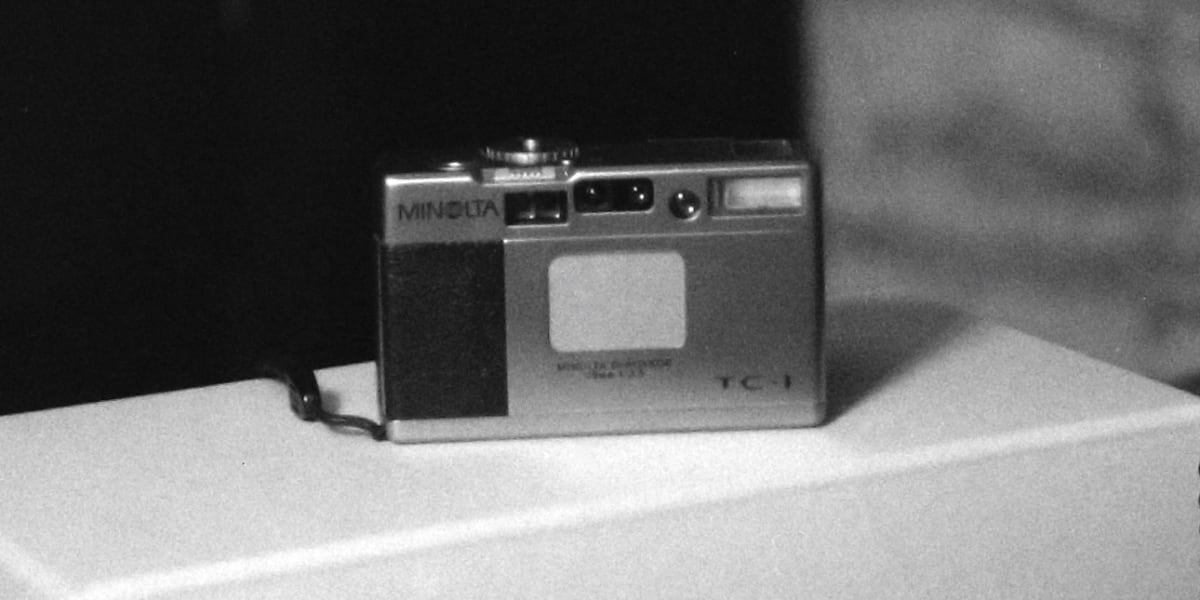
The Minolta TC-1 is compact, cute, and ready to shoot. When compared to cameras like the Nikon 35Ti, the TC-1 doesn’t look that much smaller, but in hand it feels tiny. It is nearly the same size as the Olympus XA, but it feels smaller in a pocket because it is noticeably lighter. It may not be possible to make a 35mm camera which feels any smaller than the TC-1.
It is also eager to take take photos. The Minolta TC-1 seems to have been designed with a bias towards action. The autofocus is fast, and fast to settle on infinity and fire the shutter when the button is pressed. The TC-1 has such a bias towards firing the shutter that it sometimes fires before the photographer is ready. It takes a little bit of time with the camera to get used to how sensitive the shutter button is; there is a very fine line between pressing the shutter partway down and all-the-way down. The only time the shutter gets blocked is when the flash is enabled, but the flash is not ready to fire. These design choices pair well with the 28mm f3.5 lens, which has a more forgiving depth of field.
The ergonomics of the TC-1 are also pretty amazing. It is a point-and-shoot, so it does not have all the controls of an SLR, but it does have the essentials. The TC-1 allows for manual focus, exposure compensation, ISO override, self timer use, and sticky flash settings. Point-and-shoot cameras do not have the real estate required to have dedicated buttons for each of those functions, as is possible with larger cameras such as the ɑ7. Rather than hiding the settings behind small dedicated buttons which are hard to use, or buried in an obscure menu, the TC-1 uses a function dial and a selector switch. This is a very efficient compromise which works well in practice.
歴史に名を刻む銘機であるために。
重厚な一眼レフは、いさという時のシャッターチャンスに応えているだろうか。 コンパクトカメラは、「写り」のクオリティを.牲にしすぎてはいないか。 TC-の開発は、そんなひとりの技術者の影間からはじまりました。 かつてないほど小型でありながら、かつてないほど画質と味わいのいいカメラ。 それが、ミノルタTC-1の発足の原点であり、最終目標ともなったのです あの伝説のM-ROKKORの直続を受け継ぐG-ROKKORを搭載し、 世界最小”の超精密チタンボディに、高画質と高機能を余すところなく凝縮。 道具としての感触のよさ、採作の明快さにも、徹底的にこだわりました> ミノルタTC-」。その類い稀なる質の高さは、 手にするほどに焼びを覚え、撮影するたびに愛着を深める。 写真を、一枚、一枚、大切に撮っていた頃を思い出すカメラ。ミノルタTC-l。
TC-1
有量小売価格(税別)ケース・ストタップ付¥148,000
… interpreted …
To be a signature machine that will go down in history.
Don’t solid single-lens reflex cameras respond to the shutter press when everything is just right? Aren’t compact cameras sacrificing image quality too much? The development of the TC- began with one engineer, Kagema. A camera that’s smaller than ever, but with better image quality and design than ever before. That was the origin of the Minolta TC-1 and its ultimate goal. Equipped with G-ROKKOR, which is the direct successor of the legendary M-ROKKOR, The world’s smallest ultra-precision titanium body condenses high image quality and high functionality. Thorough attention was paid to ergonomics and the user experience. Minolta TC-1. With the rare high quality of it, The more you hold it in your hand, the more it will burn, and the more you shoot it, the more you will become attached to it. A camera that reminds me of the days when I used to take pictures one by one with great care. Minolta TC-1.
TC-1
Volume retail price (excluding tax) ¥148,000 with case and strap